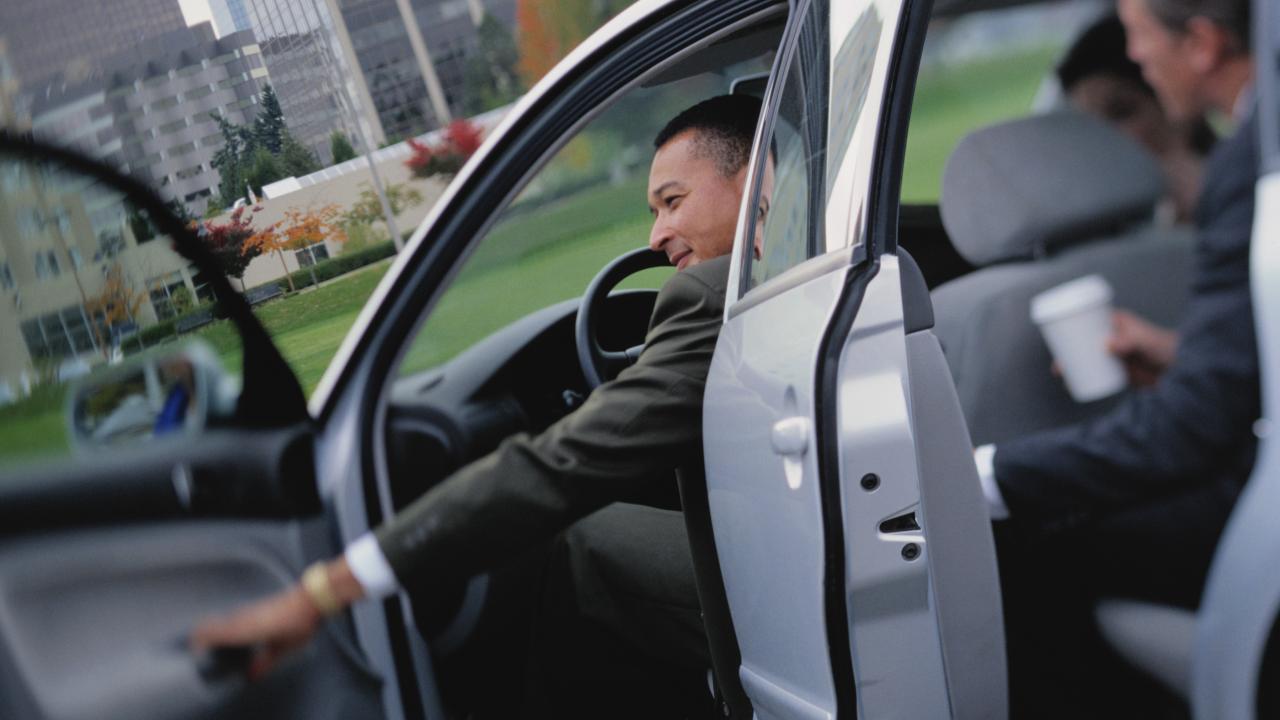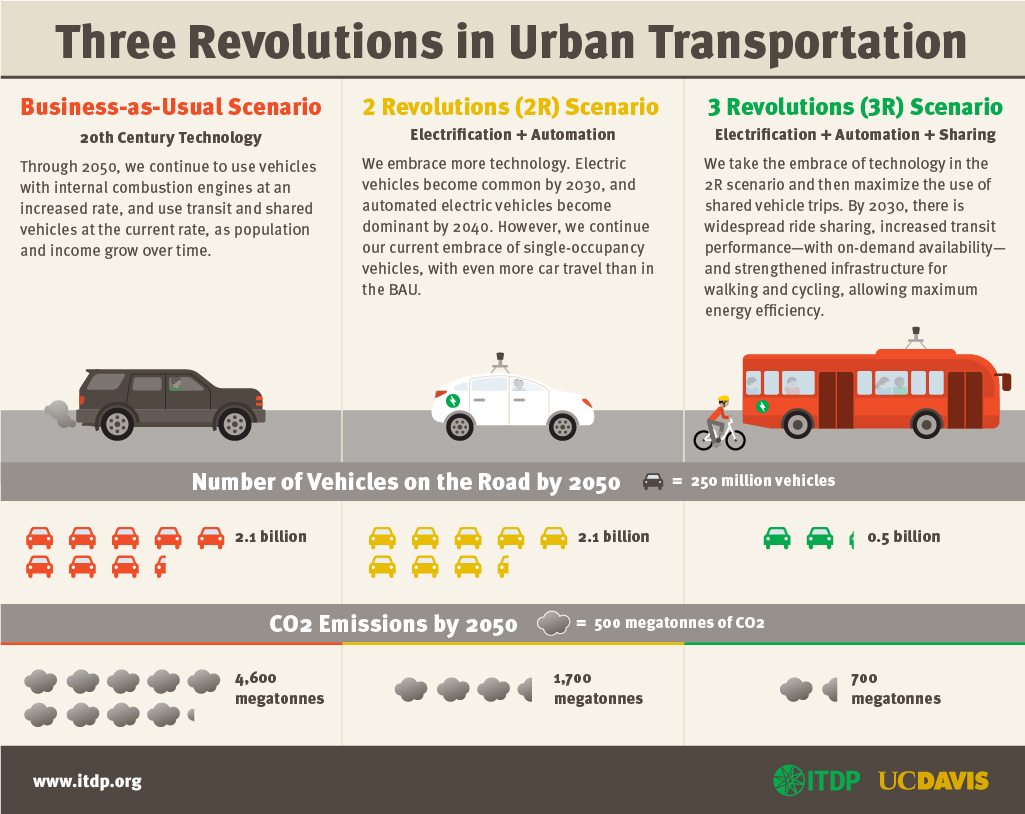Three transportation revolutions are in sight, and together, they could help reduce traffic, improve livability, eventually save trillions of dollars each year, and reduce urban transportation carbon dioxide emissions by 80 percent or more worldwide by 2050. That’s according to a report released today from the University of California, Davis, and the New York-based nonprofit Institute for Transportation & Development Policy.
Report Highlights
Compared to a business-as-usual case in 2050, a shared, electric and driverless transportation system could:
- Reduce the amount of vehicles and carbon dioxide emissions by 50 percent or greater worldwide.
- Cut global energy use from urban passenger transportation by more than 70 percent.
- Cut the costs of vehicles, infrastructure and transportation system operations by more than 40 percent.
Electrified automation without widespread vehicle sharing could save significant energy and emissions, mostly after 2030, but only if the world’s electricity production is decarbonized by 2050.
But to receive the most benefit from these revolutions, the report says the most critical component is something most preschoolers know: Sharing is caring.
Share the ride
The report delves into three urban travel scenarios surrounding three transportation “revolutions”: vehicle electrification, automation, and widespread shared mobility — which moves beyond single-occupant ride hailing.
The scenarios include:
- Business as usual: a future without widespread electrification or automation
- “2 Revolutions”: electrification and automation are embraced but shared mobility is not
- “3 Revolutions”: electrification, automation and shared mobility are all widespread
The report determined that shared mobility is the third and vital piece that could move global transportation into a future that not only saves energy and emissions but also decongests highways, frees up parking lots for other urban uses, cuts transportation costs, and improves walkability and livability.
“When it comes to cars, what we learned early in life still holds true — sharing makes everything better,” said lead author Lewis Fulton, a co-director at the Sustainable Transportation Energy Pathways, or STEPS, program of the UC Davis Institute of Transportation Studies. “All the futuristic automotive technology being developed could make our cities more livable and the air more breathable — but only if we take sharing seriously.”
Shared mobility includes ride-hailing services, but only when carrying multiple occupants. It also includes new forms of on-demand public transportation, such as small commuter buses with flexible routes. Active transportation, such as cycling, complements this scenario.
Benefits worldwide
The report spans eight global regions, including five major markets: United States, Europe, China, India and Brazil.
The different global regions vary considerably in their starting points. For example, the United States is highly car-dependent, whereas India’s challenge will be to preserve and enhance shared mobility options they already have. Yet, across the globe, the researchers found the 3 Revolutions, or 3R, scenario to hold the most environmental and societal benefit.
Potential pitfalls of not sharing
Without a concurrent shift away from private vehicle ownership and toward ride sharing, the potential for electric, autonomous vehicles to reduce traffic and sprawl are severely limited, and CO2 reductions will be significantly less than with sharing, the report says.
Electrified, driverless vehicles alone could actually increase traffic congestion. Imagine people spending even more time in their cars or the possibility of zero-occupant, driverless vehicles continuously circling the streets rather than parking.
Electrification is also very important. The report estimates that an autonomous vehicle world without electrification or trip sharing would not cut carbon dioxide emissions at all, and might increase vehicle travel by 15 to 20 percent.
“The findings point out that urban transportation has to evolve beyond single-occupancy vehicles and a single HOV lane,” said Jacob Mason, transport research and evaluation manager at ITDP. “If passenger vehicles do not become predominantly shared by 2050, our cities will continue to be choked by congestion, and defined by sprawling land development and the massive emissions this system generates. Instead, the urban residents of tomorrow should ride electric, automated, and shared vehicles into a cleaner and healthier future.”
The road to achieving emissions targets
The report, “Three Revolutions in Urban Transportation,” comes the week before an international climate change meeting begins in Bonn, Germany. The climate talks will focus on implementing the 2015 Paris Agreement, which targets a 2 degree Celsius or lower cap to an overall temperature change from global warming. This target requires all nations to cut their carbon dioxide emissions dramatically by 2050. The authors note that the “3R” scenario would meet that benchmark for cities, and possibly go further.
The authors recognize that bringing about these revolutions won’t be easy. The report outlines needed policies, and says unprecedented levels of policy support and coordination are needed at the local, state and national levels.
The report assesses policies including those that incentivize widespread adoption of electric and driverless cars, as well as support for ride sharing, public and active transport, and land-use planning that helps shorten most vehicle trips. Such policies could consider fees tied to vehicle CO2 emissions, vehicle occupancy, and possible restrictions or heavy charges on private ownership of autonomous vehicles, along with strong disincentives for zero-occupant trips. Bicycle and e-bike sharing systems also need to be encouraged along with transit system innovations.
The report was funded by ClimateWorks Foundation, William and Flora Hewlett Foundation, and Barr Foundation.
Media Resources
Lew Fulton, UC Davis Institute of Transportation Studies, (530) 752-3004, lmfulton@ucdavis.edu
Jemilah Magnusson, Institute for Transportation & Development Policy, (212) 629-8001, jemilah.magnusson@itdp.org
Kat Kerlin, UC Davis News and Media Relations, 530-750-9195, kekerlin@ucdavis.edu

